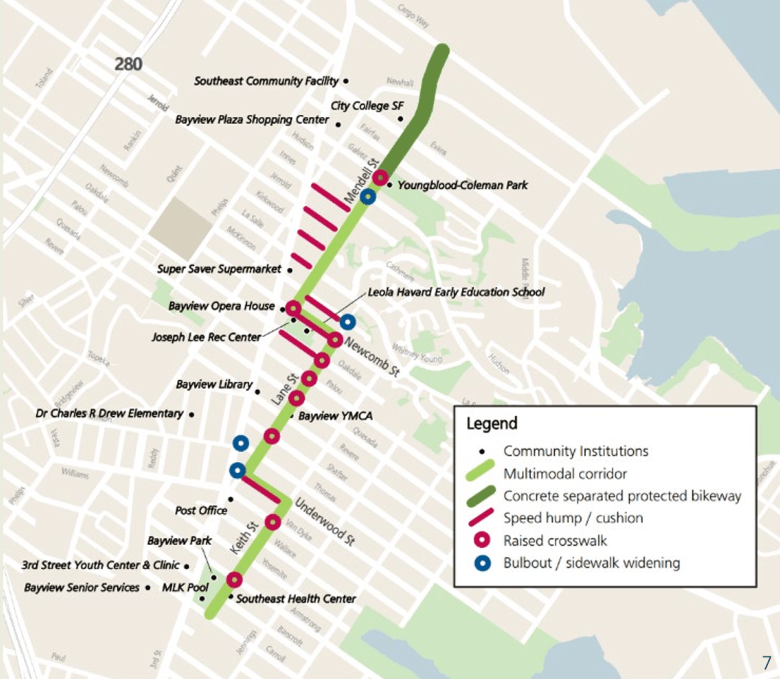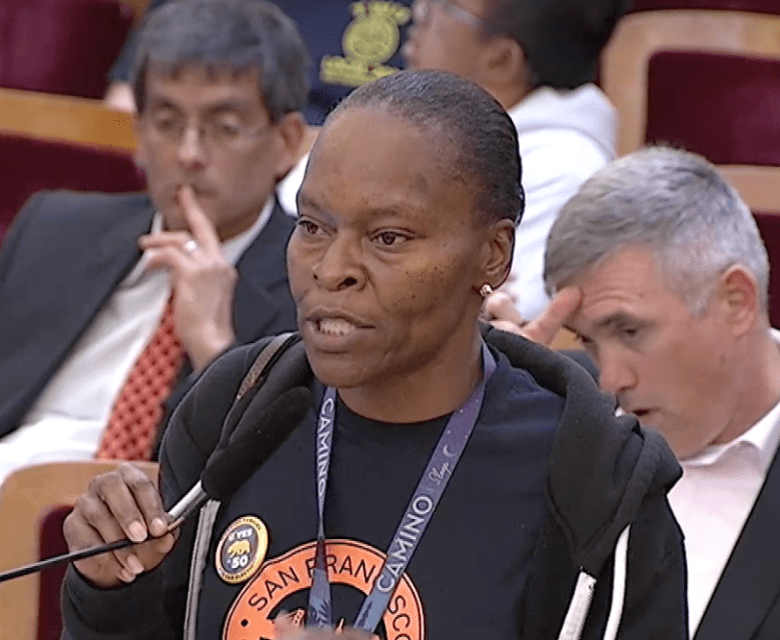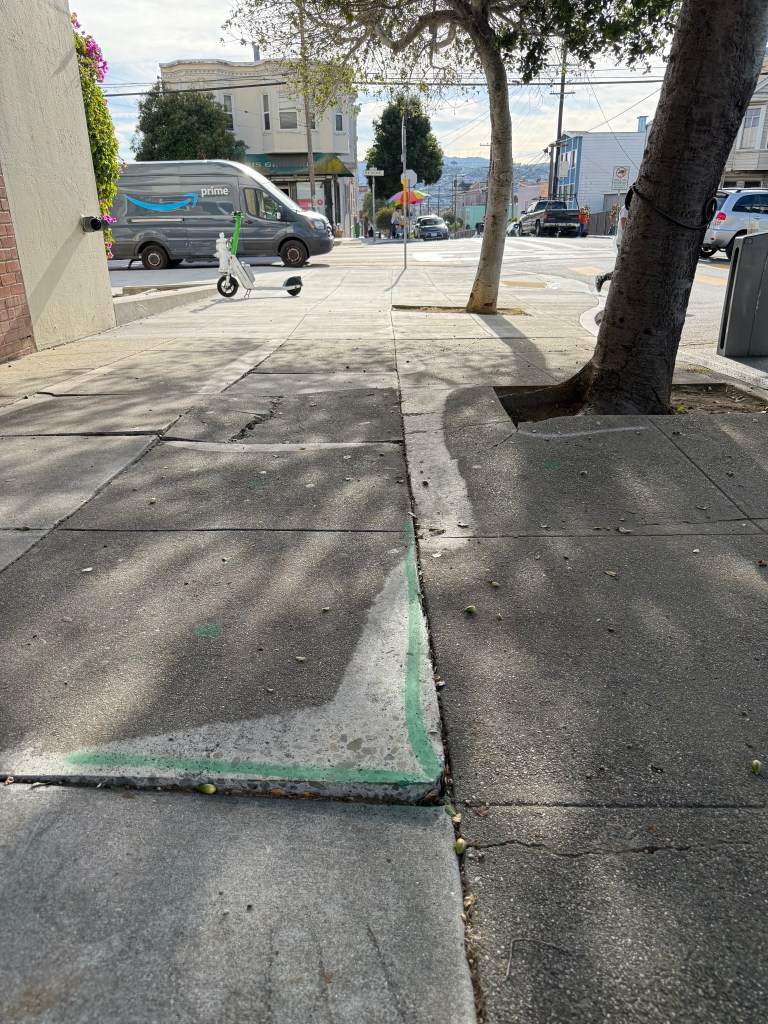Bike lanes and other street changes can spark uproars in San Francisco. But one project in the Bayview, nearly seven years in the works, has been so uncontroversial that advocates who usually show up and show out at public meetings didn’t feel the need when the project was up for approval last week.
The vote was considered a slam dunk. Instead it clanged off the rim.
After three people spoke in opposition at the meeting — one of them not even a Bayview resident — the SF Municipal Transportation Agency board quickly voted 5-2 to delay the project, which would make pedestrian-friendly changes along 1.6 miles of Bayview streets and, on a four-block stretch, add protected bike lanes.
The vote came minutes after SFMTA’s project manager voiced concern that future grant funding might require the plan’s approval by early December.
It’s not an idle worry. SFMTA in 2022 missed a project deadline for Better Market Street and squandered $15 million in federal funds.
By SF standards, three negative public comments, about five minutes’ worth, are barely a blip. By comparison, the city’s controversial housing plan has attracted several hours of comment across two recent Board of Supervisors hearings.
But the SFMTA board obliged the speakers, while acknowledging that their opposition seemed to come out of the blue. “These public comments are a little surprising given what we’ve read in our staff report,” said board chair Janet Tarlov.
For the most part, the three commenters didn’t object to the plan itself. They objected to what they considered not enough community outreach. Before their comments, SFMTA staff had walked the board through the project, including details of an outreach plan that dated back to 2023: community meetings, workshops, information tables at Bayview events, and door-to-door walks to fill in residents and merchants.
 SFMTA said they spent two years reaching out to Bayview residents and merchants to get input on the project, which would bring pedestrian safety upgrades to parts of the neighborhood including Youngblood Coleman Park. (Photo: Kristi Coale)
SFMTA said they spent two years reaching out to Bayview residents and merchants to get input on the project, which would bring pedestrian safety upgrades to parts of the neighborhood including Youngblood Coleman Park. (Photo: Kristi Coale)
The board’s vote last week means SFMTA staff now must do more outreach in the neighborhood. To what extent isn’t clear. There’s also no date set for the project to return for a vote.
“If the answer to the question of how much outreach is enough is, ‘We cannot do anything until we’ve reached out and informed every single person’ — that is not feasible,” said board member Mike Chen at the meeting.
Chen and Dominica Henderson were the only board members to vote against the delay.
Bulb-outs and islands
The Bayview Community Pathway spans a 1.6 mile route and 27 intersections in the city’s most southeastern neighborhood. Most of the plan focuses on pedestrian safety, including new corner bulb-outs, pedestrian islands, and raised crosswalks on residential streets. The northern end will add protected bike lanes on a four-block stretch of Mendell Street that curves through an industrial section of the neighborhood.
 The Bayview Community Pathway focuses on pedestrian safety improvements, covering 27 intersections along 1.6 miles. The dark green stretch at the top represents four blocks of protected bike lanes. (SFMTA)
The Bayview Community Pathway focuses on pedestrian safety improvements, covering 27 intersections along 1.6 miles. The dark green stretch at the top represents four blocks of protected bike lanes. (SFMTA)
For bike riders, the new lanes would build out an alternative route to Third Street, the Bayview’s main commercial corridor that has a Muni rail line, buses, and dozens of merchants.
Moving bikers off Third Street is meant to be a big safety improvement. The street is part of San Francisco’s high-injury network, the 12 percent of streets where most collisions happen.
The other changes — mostly along Mendell, Lane Street, and Keith Street — are meant to improve safety as well. There have been 75 collisions along the route in the last five years. (Lane is also part of the high-injury network.) Project manager Pallavi Panyam said last week that residents’ main concerns were people driving too fast and running through stop signs.
 A protected bike lane along this industrial stretch of Mendell Street would give cyclists an alternative to Third Street, which is part of the city’s high-injury network. (Photo: Kristi Coale)
A protected bike lane along this industrial stretch of Mendell Street would give cyclists an alternative to Third Street, which is part of the city’s high-injury network. (Photo: Kristi Coale)
Panyam said the outreach has had concrete results. The agency heard clearly about the importance of parking, and the design would cause a net loss of only five parking spots. Bayview households own two or more cars at twice the city average.
Panyam and Sean Kennedy, the agency’s chief planning officer, told the board last week that they worked with District 10 Sup. Shamann Walton’s office. Walton’s chief of staff Natalie Gee told The Frisc via email that the office gave the agency “a list of [community-based organizations] and groups in District 10” for outreach.
The commenter who most seemed to get the board’s attention was Najuawanda “Naj” Daniels, a self-described disabled 47-year Bayview resident who is the vice chair of the SF County Transportation Authority’s citizen advisory committee. (The SFCTA is a parallel body to SFMTA; its members are the city’s 11 supervisors.) Daniels said she was never invited to a community event and questioned SFMTA’s outreach claims. She said the kids shown attending events on the agency’s slides “don’t look like the kids I live near.”
 Bayview resident Najuawanda “Naj” Daniels questioned SFTMA’s outreach claims at the meeting, turning the plan’s expected approval into an indefinite delay. (SFGovTV)
Bayview resident Najuawanda “Naj” Daniels questioned SFTMA’s outreach claims at the meeting, turning the plan’s expected approval into an indefinite delay. (SFGovTV)
(Daniels mentioned her home address during her comment; the address is more than a mile away from the bike lane portion of the project.)
SFMTA’s Panyam said that the agency spent two years engaging with “over 4,000 Bayview residents to identify their needs and priorities.” The outreach included door-to-door visits with Third Street merchants, and information tables at 14 community events such as Bayview Sunday Streets.
The SF African-American Arts and Cultural District, which supports the project, joined SFMTA for the merchant walk. Another community organization, MAGIC, helped SFMTA with other outreach. Its executive director Brittany Ford told The Frisc that neighbors who participated in a walk-through along the project’s route in June were excited “about the possibility of updates to Mendell and Evans [Street],” including dedicated pedestrian signals and the repair of uneven sidewalks.
We were surprised to see the [board] decline to vote. It’s a good reminder that it’s crucial to show city leaders we support and are asking for these improvements.
Claire Amable, SF BIcycle COALITION’s Director of Advocacy
In addition to the two years of outreach that Panyam detailed last week, SFMTA has been canvassing the neighborhood about a broader transportation plan since 2018.
An SFMTA spokesperson said the agency will present the project at another meeting on Nov. 20 at the Southeast Community Center.
What about the grant?
In 2022, the Bayview Community Pathway received its first major grant: $12.3 million from the state’s Active Transportation Program. But it didn’t come all at once. SFMTA must hit milestones to unlock phases of the funding.
Last week, project manager Panyam warned that the plan needs SFMTA board approval by Dec. 4 to trigger its next funding milestone. (It’s unclear how much would be paid out.)
 The project is supposed to fix broken sidewalks, like the one here on Lane Street in front of the Bayview YMCA. (Photo: Kristi Coale)
The project is supposed to fix broken sidewalks, like the one here on Lane Street in front of the Bayview YMCA. (Photo: Kristi Coale)
Panyam suggested that a vote at the next board meeting on Nov. 18 would allow time to meet the deadline. Despite that looming date, other officials seemed unfazed by the warning. SFMTA executive director Julie Kirschbaum balked at putting “a tight clock” on more outreach. She asked her planning chief Kennedy for his comfort level with tabling the vote, and he said he was fine waiting “for the next several weeks.”
Agency spokesperson Michael Roccaforte did not clarify whether Dec. 4 is a hard-set deadline for funding. Instead, he said as long as the project is “delivered on a certain schedule,” SFMTA can meet the conditions of the grant.
SFMTA says the project will go through a two-year design phase before construction starts in 2028.
A spokeswoman for the granting agency, the California Transportation Commission, said its two day meeting on Dec. 4 and 5 might include a hearing on SFMTA’s request for design-phase funding. But she did not comment on the amount of funding, nor did she confirm that SFMTA’s request will be on the final agenda, which is due out Nov. 21.
It’s unclear how much more outreach SFMTA needs to do. Other than the three commenters last week, SFMTA staff told The Frisc there were “a few emails” that came in as comments as well. Roccaforte said the emails were generally positive, but some expressed concerns over parking. The agency declined to share the emails.
One bicycle advocate said her group has learned its lesson. “We were surprised to see the [board] decline to vote,” says SF Bicycle Coalition director of advocacy Claire Amable. “It’s a good reminder that it’s crucial to show city leaders we support and are asking for these improvements, both in the engagement process and at critical moments like the approval vote.”
More from The Frisc…

